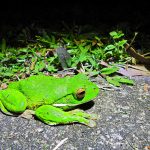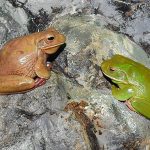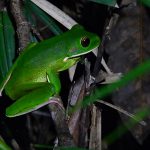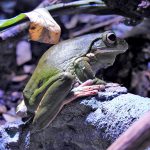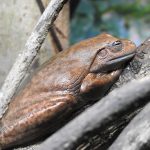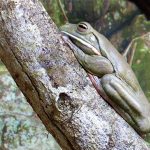WHITE-LIPPED TREE FROG
White-lipped Tree Frog
Step into a warm, rain-drenched night in tropical Queensland. The air smells of wet leaves and earth. High in a palm frond, a glossy green frog settles its huge toes on the slick surface—and barks. The sound is deep and dog-like, echoing across a garden pond. This is the White-lipped tree frog, the world’s largest tree frog, and a charismatic ambassador of Australia’s Wet Tropics.
At a glance
| Feature | Detail |
|---|---|
| Scientific name | Litoria infrafrenata |
| Common names | White-lipped tree frog, Giant tree frog, New Guinea tree frog |
| Status | IUCN: Least Concern |
| Size | Females up to ~14 cm (SVL); males smaller |
| Distribution | North-eastern Australia (Wet Tropics of Queensland), New Guinea, nearby islands |
| Habitat | Tropical rainforest, mangroves, gardens, forest edges—always near water |
| Call | Deep, barking “crawk… crawk…” especially after rain |
| Claim to fame | Largest tree frog on Earth |
SVL = snout–vent length
How to identify one
- Bold white stripe along the lower lip and jaw, often running back toward the shoulder—this is the “white lip.”
- Back is smooth and bright leaf-green (can shift to olive or brown when resting); belly white to cream.
- Huge toe pads and strongly webbed toes for climbing in wet, glossy foliage.
- Eyes large and golden-brown, with horizontal pupils.
- Immense size for a tree frog; an adult female fills the palm of an adult hand.
Tip: It’s often confused with the Australian green tree frog (Litoria caerulea). The White-lipped tree frog is typically larger and shows that crisp white lip line; the green tree frog lacks the strong white stripe.
Voice and behaviour
- Call: A resonant, barking “crawk” or rolling croak, spaced every few seconds, heard on humid nights and after summer storms.
- Nocturnal and arboreal: by day they rest in cool, shaded spots—banana leaves, palm sheaths, verandas; by night they hunt.
- Diet: Mostly large insects—moths, beetles, crickets, roaches—and sometimes other small invertebrates.
- Movement: Broad, deliberate climbs using those adhesive pads; powerful jumps when startled.
Close your eyes and you can almost feel the damp warmth of the rainforest and hear the rhythm of the call, like a soft drumbeat coming from the canopy.
Range and habitat
- Australia: Primarily the Wet Tropics of north-eastern Queensland—from roughly the Townsville region north through the rainforest belt to Cape York and the Torres Strait islands.
- Also widespread across New Guinea and nearby islands.
- Habitats include lowland rainforest, monsoon forest, mangroves, and human-modified areas such as gardens—provided there is reliable moisture and freshwater for breeding.
Life cycle
- Breeding season: Mostly the wet season (summer), triggered by heavy rain.
- Eggs: Laid as a floating film or scattered clumps in still or slow-moving water—ponds, dams, flooded ditches.
- Tadpoles: Large, often golden-brown with darker mottling; they graze on algae and biofilm.
- Metamorphosis: From egg to frog can take several weeks to a few months, depending on temperature and water quality.
- Young frogs: Tiny green jewels that climb into vegetation soon after their tails are absorbed.
Ecology and role in the ecosystem
- Predators include snakes, birds, large spiders, and monitors; tadpoles are preyed upon by fish and aquatic invertebrates.
- As voracious insect-eaters, they help regulate insect populations.
- Sensitive skin makes them living indicators of water and habitat quality—when they thrive, the local wetlands are usually healthy.
Conservation notes
- Global status is Least Concern, but local pressures matter:
- Loss and fragmentation of rainforest and wetlands
- Road mortality on warm, wet nights
- Disease risk from chytrid fungus (
Batrachochytrium dendrobatidis) - Climate extremes that alter breeding wetlands
- Simple actions help:
- Create a fish-free backyard pond with leaf litter, gentle ramps, and native plants.
- Avoid pesticides and herbicides; use frog-friendly garden practices.
- Keep domestic cats indoors at night, particularly in the wet season.
- Never relocate frogs between properties or waterways—this spreads disease and disrupts local genetics.
- If you must handle a frog (ideally, do not), wet, clean hands and minimal contact reduce stress and skin damage.
How to see one (ethically)
- Look and listen on warm, humid nights after rain in coastal north Queensland.
- Scan eye-level to several metres up—palm and banana leaves, fence lines, window ledges near outdoor lights.
- Use a dim torch and observe quietly; bright lights and handling can stress amphibians.
Frequently confused with
- Australian green tree frog : Smaller on average, lacks the crisp white lip stripe, broader distribution into drier regions, softer “wark… wark” call.
- White-lipped is mostly a tropical species in Australia.
Quick facts to remember
- The world’s largest tree frog lives right in Australia’s Wet Tropics.
- That neat white stripe along the lip is the giveaway.
- It calls like a small dog after summer rain.
- Healthy frogs often mean healthy water.
The White-lipped tree frog is more than a rainforest resident—it is a warm, living thread in the fabric of tropical nights. Protect the wetlands, and you protect the voice that rises after the rain, calling life back to the forest.

